Isabella Bradford's Blog, page 5
October 13, 2018
Breakfast Links: Week of October 8, 2018
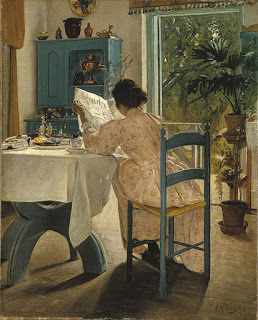 Breakfast Links are served! Our weekly round-up of favorite links to other web sites, articles, blogs, and images via Twitter.
Breakfast Links are served! Our weekly round-up of favorite links to other web sites, articles, blogs, and images via Twitter.• Enormous farm animals: the history behind an " absolute unit ."
• Williams & Sowerby, silk mercers of Oxford Street who produced tissue de verre, or "glass cloth. More about tissue de verre here.
• Ectoplasm and Helen Duncan , the last British woman tried for witchcraft - in 1944.
• "I have heard some of the Democratic rejoicing": Abigail Adams' last letter to husband John, 1801.
• Image: Know Your Pugs, from Strand Magazine, 1892.
• An 1820s shooting coat , worn for hare-coursing .
• Dozens of costume history books to read on line via The Getty.
• The challenges of war to a woman: Baroness Frederika von Riedesel describes the second Battle of Saratoga,
1777.
• Image: Gorgeous diamond and emerald parure designed by Prince Albert for Queen Victoria.
• A 12thc relic meets 21stc technology.
• Frances Gabe and her amazing self-cleaning house .
• In the 1870s, a radical journalist and a photographer documented London street life with these images.
• Late 19thc silk Chinese woman's surcoat features flying cranes against mountains and clouds.
• Image: Unusual Georgian mourning brooch c1780 with hairwork tomb, weeping willow, and urn.
• Every Marine carries the flag: a brief history of the US Marine Corps flag .
• Little ladies: Victorian fashion dolls and the feminine ideal.
• The twenty-five most famous residents of New York City's cemeteries .
Hungry for more? Follow us on Twitter @2nerdyhistgirls for fresh updates daily.
Above: At Breakfast by Laurits Andersen Ring. Private collection.
Published on October 13, 2018 14:00
October 11, 2018
Friday Video: Getting Dressed during World War One: A VAD Nurse
Susan reporting,
Our friends at Crow's Eye Productions have ventured into the 20thc for this video. Featured in this video are the nurses who served in the Voluntary Aid Detachment (VAD) run by the British Red Cross Society during World War One. The VAD was a voluntary unit of civilians who provided nursing care to British military personnel; the majority of the volunteers were women and girls from the middle and upper classes who wished to contribute to the war effort. While most of these volunteers (over 60,000 by 1918) lacked the medical training of professional nurses, by the war's end many had proven that they were not mere "society ladies." They served bravely and competently not only in auxiliary hospitals at home and in the field, but as ambulance drivers and cooks as well.
The accomplishments of the VAD are especially impressive in light of their uniforms - no easy-care scrubs here! This video shows the staggering amount of clothing that these women were expected to wear as they performed their duties. In time the war would mark a dramatic shift in the role of modern women and how they dressed, but these uniforms clearly belong more to the Edwardian era than to the 1920s flappers.
An additional note: the video was filmed on location at Stanhope Hall, Horncastle, the site of a former VAD Hospital.
Many thanks to producer and costumer Pauline Loven for sharing this video with us!
If you receive this post via email, you may be seeing an empty space or black box where the video should be. Please click here to view the video.
Published on October 11, 2018 21:00
October 10, 2018
The Dickey, or, Abominable False Front
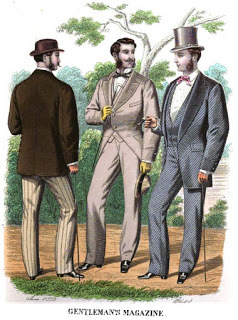 August 1873 Men's Fashions
Loretta reports:
August 1873 Men's Fashions
Loretta reports:The author of this 1876 guide to men’s dress did not mince words when it came to false shirt fronts. One can only imagine what he'd have to say about, oh, man buns or low-hanging trousers.
~~~
BEAU BRUMMEL said, “A gentleman should show clean linen, and plenty of it.” The first part of this sentence is strictly true, the second less so. There is no need, having a clean shirt on, to publish the fact, or to lead the public to infer you wear it as a disguise by undue exhibition of it. “Virtue is its own reward :” so the assumption of clean underclothing generally, even if its light be kept beneath a bushel, should afford the wearer the same pleasure as if ostentatiously paraded. When I see a man placarding his chest with a wide expanse of lawn, and exhibiting an unnecessary amount of cuffs, I infer he has got on neither a clean nor white shirt. The surmise generally proves correct.Interlined Shirt Bosoms 1912I often see in haberdashers' shops an exaggerated collar and lapel in one, designed to cover manly bosom. The commercial name of this impious fraud is called a Dickey. This felonious impostor must be made away with. No one with any self-respect can wear a dickey. A man clad in such an unmitigated imposition is a whited sepulchre of the very blankest type. If the reader knows any so depraved even to possess one, let him persuade the wretched man to pause, ere too late, in his headlong career—to burn the spurious rag, and he can then exclaim, with regenerated heart, “Richard” (not Dickey, mind) “is himself again!”
Many say, however, when this charge is brought against them, that they suffer from neuralgia, lumbago, and tic-douloureux and ... various other ailments ... Well, what excuse is this? I do not prohibit flannel —wear an under flannel shirt—two if you like; but you must cover it with an entire white shirt, not an aliquot part of it. If hypocrisy be the homage which vice pays to virtue, then the assumption of dickey is a sneaking admission of the necessity for showing clean linen, and a discreditable way of making a sham composition with the subject.
— The Gentleman's Art of Dressing with Economy. By a Lounger at the Clubs (1876)
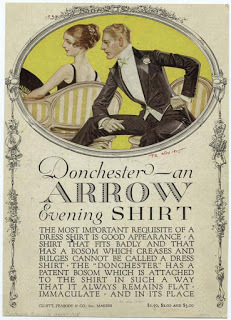
The Lounger's disapproval did not lead to the rapid extinction of the dickey. On the contrary, it lived on into the 20th century, and it isn't dead yet.
Images: August 1873 Men’s Fashions , from the Gentleman's Magazine of Fashion, via Google Books.
Interlined Shirt Bosoms (1912), and Arrow Donchester shirt 1915, courtesy New York Public Library.
Clicking on the image will enlarge it. Clicking on the caption will take you to the source, where you can learn more and enlarge images as needed.
Published on October 10, 2018 21:30
October 8, 2018
An 1880s Bustle Gown, Intriguingly Unfinished
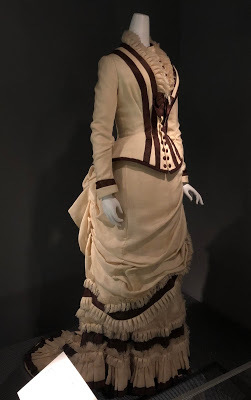 Susan reporting,
Susan reporting,Here's another fascinating garment from the Fashion Unraveled exhibition currently at the Museum at FIT in New York through November 17, 2018 (The first I shared was this 18thc gentleman's waistcoat that was remade for a woman in the 1950s). As the Museum's notes explain, this exhibition isn't about perfectly preserved, pristine garments. Instead, it "highlights the aberrant beauty in flawed objects, giving precedence to garments that have been altered, left unfinished, or deconstructed."
As a fiction writer, I'd add one more to that list: garments that survive in such an interesting state that they beg to tell their story.
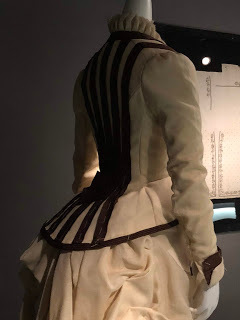
This white bustle gown from the 1880s is instantly intriguing. Even an untrained eye would see that there's something not quite right about it. Instead of the usual crisp, almost architectural lines characteristic of fashion of the period, this gown seems almost droopy. There's a reason for this, of course: it was never finished. The brown silk taffeta trim is only basted into place (the long white running stitches are quite visible), the raw-edged trim is still tentatively arranged in some places, and the gathers that arrange the bustle and overskirt are decidedly lopsided. The cream-colored wool was never steamed and pressed, leaving the seams soft and bulky, almost rumpled.
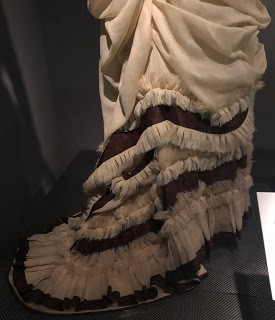
And yet this was clearly going to be a stylish gown, and likely a costly one, too. Even if a customer changed her mind in the middle of the process, why wasn't it remodeled to fit another wearer? Why wasn't all that brown taffeta and raw-edge, fringed trim removed to use in another way? Why was it simply abandoned in this tantalizing state?
No one today has the answers. But it could certainly inspire a wealth of fictional explanations, couldn't it?
Dress, c1880, USA. Museum at FIT.
Photographs ©2018 by Susan Holloway Scott.
Published on October 08, 2018 21:00
October 7, 2018
The Fires of October 1871
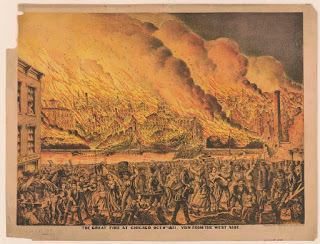 Chicago Fire 1871
Loretta reports:
Chicago Fire 1871
Loretta reports:Nearly every major city in the world has endured a catastrophic fire. Some happen during wartime , sometimes it's arson, but in the majority of cases, an act of nature or an accident sets things off.
Two of the most well-known U.S. fires are those in Chicago (1871) and San Francisco (1906), the latter resulting from earthquake damage. The former supposedly started when Mrs. O’Leary ’s cow kicked over an oil lamp in the barn, but that’s only one of several versions of what happened.
An article in the Library of Congress’s Today in History (please scroll down) taught me something I didn’t know: On the same day as the Chicago blaze, large parts of Michigan and Wisconsin , including several cities, burnt to the ground. The fires left at least 1,200 people—possibly twice that number—dead. The summer and early autumn had been unusually dry and October was unusually warm. Fierce winds spread the fires far and quickly. In other words, the Midwest was a tinderbox in October 1871.
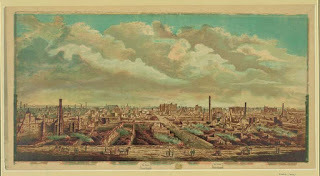 Chicago after the Fire
Chicago after the Fire
Chicago, like London at the time of the Great Fire a couple of centuries earlier, was built mostly of wood. So were other cities. Regulating Mother Nature is a challenge, but given London's experience, you’d suppose cities would take precautions, establishing building codes to reduce risk, as London did back in the 1600s. But usually what happens is that only a catastrophe brings about change, and cities had to work it out for themselves. From what I can ascertain, they usually did so, establishing building codes and other regulations as well as strengthening their firefighting organizations.
For some perspective on how much of the world has burned down over the centuries, you might want to take a look at Wikipedia’s List of Town and City Fires. It provides some fascinating information and food for thought.
Images: The Great Fire at Chicago Oct. 9th 1871. View from the West Side ; Chicago after the Fire , courtesyLibrary of Congress Prints and Photographs Division Washington, D.C. 20540
Clicking on the image will enlarge it. Clicking on the caption will take you to the source, where you can learn more and enlarge images as needed.
Published on October 07, 2018 21:30
October 6, 2018
Breakfast Links: Week of October 1, 2018
 Breakfast Links are served! Our weekly round-up of favorite links to other web sites, articles, blogs, and images via Twitter.
Breakfast Links are served! Our weekly round-up of favorite links to other web sites, articles, blogs, and images via Twitter.• A specialized working horse in the 19th century: the funeral horse .
• What did 18thc ladies wear under a chemise a la reine ?
• A forgotten letter by early UK suffragette Annie Kenney is discovered.
• A mourning ring for Louis XVI, created to coincide with the reinstatement of Louis XVIII, represents not only grief, but a new nationalism.
• " Toss up, pitch and hustle , and any other games of chance": all were banned in 1775 by General Washington.
• When the wardrobe is (intentionally) the star of the film: "Dressing a Renaissance Queen ."
• Image: This renowned 18th thoroughbred was named " Potoooooooos " pronounced "Pot-eight-Os".
• Rediscovering Julia Rush , another unsung Founding Mother.
• Queen Victoria's Hindustani diary .
• A magnificent embroidered evening dress , c1798-1800.
• When fashion set sail: the truth about those miniature ships in 18thc French ladies' hair.
• " To Order Mushromes ": a transcribed recipe to try from Jane Dawson's 17thc manuscript cookbook.
• Art nouveau meets baroque in Bristol.
• Image: "Outbursts of Autumn: Monstrous Muffs and Startling Stoles", 1910.
• Victorian advice for men on civility towards women.
• Hunt is on for a lost 18thc masterpiece (last seen in the 1940s) by Angelica Kauffman , one of the greatest women artists.
• How 19thc women in Edinburgh, Scotland helped enslaved Americans on the road to freedom.
• A grab-bag of historical styles, yet somehow it works: the eclectic, elegant 1887 Honeywell-Roberts house in Manhattan.
Hungry for more? Follow us on Twitter @2nerdyhistgirls for fresh updates daily.
Above: At Breakfast by Laurits Andersen Ring. Private collection.
Published on October 06, 2018 14:00
October 4, 2018
Friday Video: Self-Defense for Women
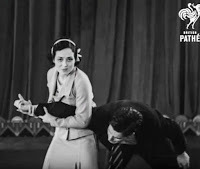 Loretta reports:
Loretta reports:In the course of researching some 19th century self-defense materials, I learned that, even before Victorian times, women could learn self-defense techniques. It wasn’t easy, and it wasn’t exactly respectable, but it could be done. However, by the Edwardian era, women are beginning to get formal instruction in martial arts, like ju jitsu (you can learn a great deal more about this at the Bartitsu Society website ).
Some women, trained in these arts, provided protection for suffragists.
This film is a bit later—1933—but the moves employ the same principles.
Self-Defence Tutorial from 1933 | British Pathé
Image is a still from the video.
Readers who receive our blog via email might see a rectangle, square, or nothing where the video ought to be. To watch the video, please click on the title to this post (which will take you to our blog) or the video title (which will take you to YouTube).
Published on October 04, 2018 21:30
October 1, 2018
Fashions for October 1902
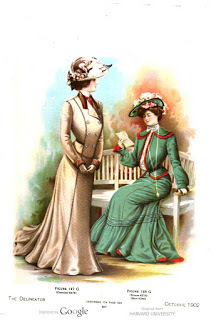 October 1902 Day Costume
Loretta reports:
October 1902 Day Costume
Loretta reports:The Delineator is quite a bit different from the ladies’ magazines I’ve used for earlier time periods. The World of Fashion, La Belle Assemblée, and other 19th century periodicals were aimed at upper class women. Those magazines described the fashions, but didn’t explain how to make them, because their audience’s clothes were made by dressmakers.
The Delineator’s market is altogether different. They're selling patterns to women who make at least some of their own and their family’s clothes. My guess is that some dressmakers (those outside the high fashion realms) might have found it useful, too, especially regarding latest trends. As a result, we get a wealth of detail about the clothes and their construction—valuable especially for writers setting stories in this time period or those simply interested in post-Victorian fashion.
Like other ladies’ magazine of the 1800s, 1900s, and today, though, the Delineator offers a summary of the latest trends in the introduction to their long fashion section. You can read about what’s hot for October 1902 here . A few years later, the silhouette changed quite a bit, as I pointed out in this post .
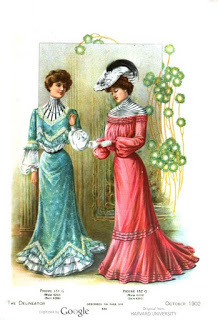 October 1902 Tea or Reception Dress
October 1902 Tea or Reception Dress
Because the descriptions are so long, I’m not going to attempt to clip them, but will instead provide links. Day Costume Description here . Tea gowns description here (scroll down to Figures 151G and 152G.
Images via Hathi Trust.
Clicking on the image will enlarge it. Clicking on the caption will take you to the source, where you can learn more and enlarge images as needed.
Published on October 01, 2018 21:30
September 30, 2018
Cha-ching! A Splendid 1894 Cash Register
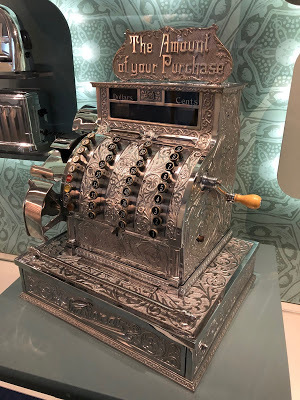 Susan reporting,
Susan reporting,In these days of credit card scanner, swipers, and readers, I bet there are more than a few of our readers who won't know what this is. It's a cash register, and an extravagantly beautiful one at that.
Made in 1894 by the National Cash Register Company, this impressive nickel-plated register (Model 79) was an example of the latest in retail. By the end of the 19thc, Americans had more cash (and more credit) to spend, and stores had grown in size and splendor. Consumers were tempted with a wealth of increasingly mass-produced products, all presented in an elegant setting that encouraged the experience of shopping - itself a 19thc verb. This over-sized register, gleaming and ornamented like a piece of fine silver, would definitely have been part of the experience.
But cash registers were initially designed not for the sake of the customers, but to combat the petty thievery of clerks by keeping track of transactions. According to the museum's web site, the register "has three columns of keys for entering numbers, and a fourth column of function keys. The operating crank is on the right side, the cash drawer is below, and a receipt dispenser is on the left side. Pop-up indicators above the keys indicate the total purchase." High-tech, indeed.
The register is currently on display as part the " Art in Industry " exhibition at the Smithsonian's National Museum of American History in Washington, DC.
Photograph ©2018 Susan Holloway Scott
Published on September 30, 2018 17:00
September 29, 2018
Breakfast Links: Week of September 24, 2018
 Breakfast Links are served! Our weekly round-up of favorite links to other web sites, articles, blogs, and images via Twitter.
Breakfast Links are served! Our weekly round-up of favorite links to other web sites, articles, blogs, and images via Twitter.• Following the fashions : a basic American pastime.
• Paintings of unruly 19thc children by Andre Henri Dargelas (1828-1906)
• The history of surgical gloves includes a love story.
• Every night, the U.S. Constitution is lowered into an atomic-bomb-proof vault to protect it from thieves and terrorists.
• Image: Skulls of medieval soldiers, fused with the chain mail they'd been wearing when they died.
• A 17thc sailor's shameful confession discovered in his journal - though there's a kind-of happy ending.
• Stylish woman's hat c1880 cleverly uses pleated silk trim to replicate the feathers (or wings) of endangered birds.
• Teeth whitening in the Victorian era, from charcoal paste to sulfuric acid.
• Image: Road-trip beauties posing with a car (and some canoe paddles) c1920.
• Samuel Pepys was a 17thc visitor: the Cheesecake House in Hyde Park.
• Newly digitized online: 1,600 pre-1900 books on astrology, magic, alchemy, and the occult.
• Exercise for women in the early 19thc.
• A serial killer on the island of Jamaica, 1773.
• Image: The 18thc Shell Cottage , Carton House, County Kildare.
• Founded in London in 1875: the Metropolitan Association for Befriending Young Servants .
• How the Rolling Stones in 1968 ended up at 17thc Swarkestone Pavilion .
• While Europe's oldest intact book was found in the coffin of a saint.
Hungry for more? Follow us on Twitter @2nerdyhistgirls for fresh updates daily.
Above: At Breakfast by Laurits Andersen Ring. Private collection.
Published on September 29, 2018 14:00



